Once upon a time: Danny Sullivan and the Alfa adventure
Photo Credit: Mariann Nagy
The Gist
On paper, Danny Sullivan made an adventurous, yet promising choice when he joined Pat Patrick Racing and Alfa Romeo for the 1991 CART season. But early optimism about the project soon turned into frustration, as the 1985 Indianapolis 500 winner tells editor-at-large Jeroen Demmendaal in a Champweb exclusive.
Once upon a time: Danny Sullivan and the Alfa adventure
The history of IndyCar racing is littered with valiant efforts to achieve success, some more well-planned and viable than others. But surely one of the most ambitious, yet curious efforts must be the one by Alfa Romeo in the heydays of CART/IndyCar, as it tried and failed to make it to victory lane with its works racing engine between 1989 and 1991 before throwing the proverbial towel.
On paper, the Italian manufacturer seemed to have everything sorted out by 1991, as it was about to embark on its third year in American open-wheel racing. It had teamed up with Patrick Racing, one of the best organised teams in the paddock. It had secured a brand new Lola T91/00, the chassis of choice in 1991. Funding wasn't an issue, with a major blue chip sponsor in the form of Miller beers. And it had a championship-winning driver in former Penske ace Danny Sullivan, son of Louisville, Kentucky.
So why didn't it work? Was it a lack of effort, an overdose of Italian bravado, a shortage of good fortune? Probably none of the above, maybe a little bit of everything. Or as Danny Sullivan himself tells me, as we look back at that fateful time in 1991: "Engines are difficult. It's never just the pistons or the fuel management. It's always a combination of things. Alfa had a lot of great people and it was never for a lack of trying. It just didn't have any power!"
Picking up where Ferrari left off
First a little bit of back story then. Because in an era where many are hoping for an announcement about a third engine manufacturer joining the NTT IndyCar Series, it might sound outlandish that in the late 1980s and early 1990s, around half a dozen manufacturers were vying to supply IndyCar racing teams with engines. Chevrolet was the dominant force, Porsche wanted to be, while the lesser gods opted for more affordable, but underpowered or unreliable Cosworth, Buick and Judd engines. And then there was Alfa Corse.
Alfa Romeo had inherited the IndyCar-programme that was under consideration by its sister brand Ferrari only a few years earlier. Plans had been drawn up in Maranello to enter IndyCar as of 1987, while reigning CART champion Bobby Rahal was approached about a possible ride and even visited the factory in Italy. In the end, the Ferrari plans turned out to be a bargaining chip used by Enzo Ferrari in his political battle with the powers that be in Formula 1, and the dream of a full-blown Ferrari IndyCar effort ended there and then.
But while the IndyCar chassis built by Ferrari was shelved and ended up in a museum, the engine project was kept alive for Alfa Romeo, which saw IndyCar as a perfect platform for building and promoting its business in the United States. But rather than trying to go it all alone, by also building its own chassis like Penske did and the short-lived Porsche effort aimed to do, Alfa decided to team up with March Engineering.
March, long a dominating force on the IndyCar circuit throughout much of the 1980s, had fallen on rough times come 1988 and was losing ever more ground (and customers) to Lola. So it saw the Alfa Romeo programme as a means of salvaging its dwindling IndyCar programme. A purpose-built chassis for the Alfa power plant saw the light of day in early 1989, after which Colombian Roberto Guerrero was signed up as lead driver for the effort, together with the Alex Morales racing team.
The Alfa-powered March got its first taste of competitive action halfway through 1989, when the team showed up in Detroit. A very acceptable eighth place finish on the Mean Streets of the Motor City turned out to be the highlight of that season, which ended up being a glorified testing programme. Not only did the engine lack power, it also displayed a worrying lack of reliability. But at least the team was racking up mileage and knew its position in the pecking order.
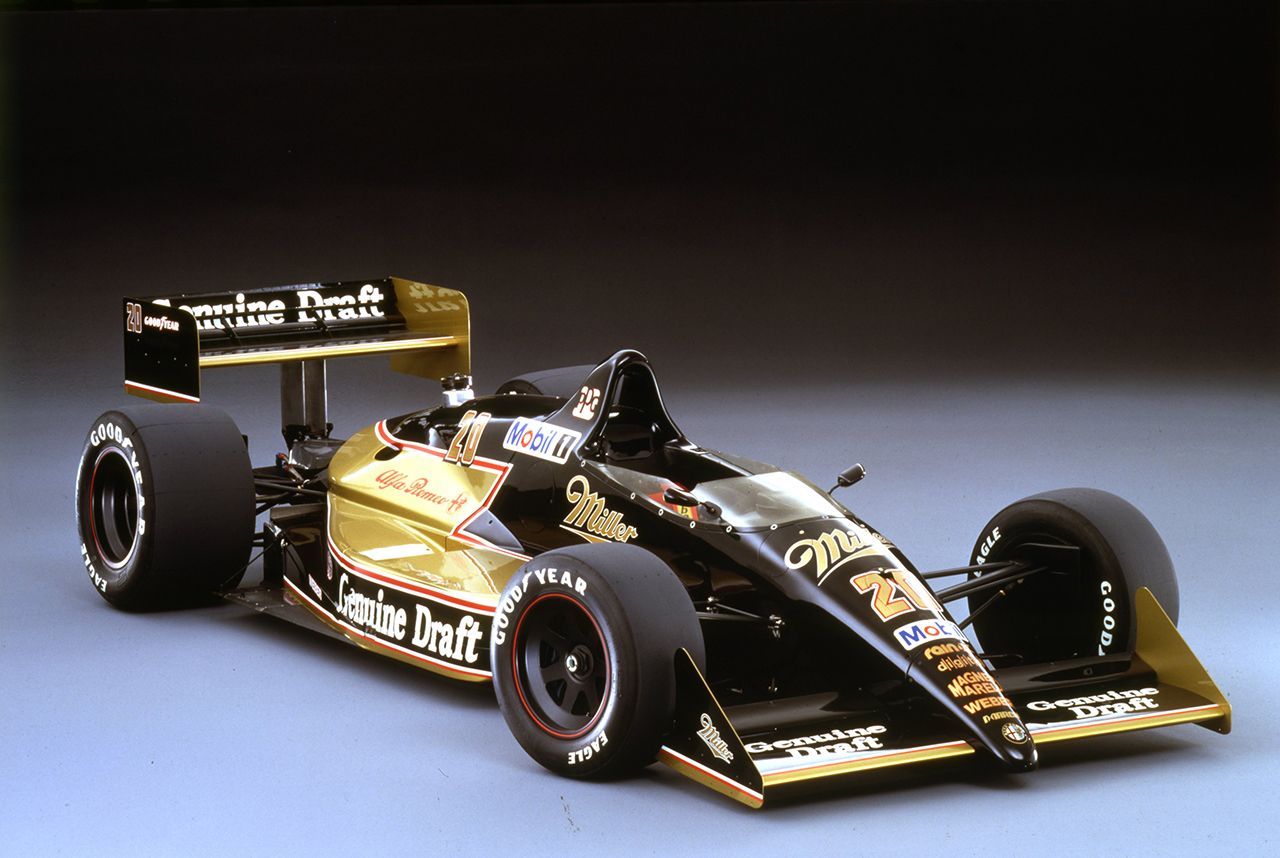
The 1990 March Alfa Romeo: it looked better than it performed. (Pic: March Archives)
For 1990, Alfa Romeo and March ended their collaboration with Alex Morales and instead joined forces with Pat Patrick Racing, which had just won the title with Emerson Fittipaldi but lost both its driver and Marlboro funding to Penske. A new title sponsor arrived in the form of Miller Genuine Draft beers, draping the car in a stylish black and gold livery to replace the rather bleak and decal-light colour scheme of 1989. Guerrero remained the lead driver, while a second car was fielded for Al Unser Sr at Indianapolis and Michigan.
That made 1990 a significant step up from the previous year. But what the new set-up did not deliver was a significant improvement in performance. The team struggled with the March, and ahead of Michigan switched to a 1990 Lola chassis. While the Lola switch provided a slight boost, successes were few and far in between, with a fifth place at Michigan the best result for Guerrero. Reliability and speed remained an issue throughout the season and the Colombian finished a distant sixteenth in the 1990 CART World Series final standings.
Which meant that for 1991, things had to change yet again. Guerrero was, justifiably or not, seen as a good development driver but not as the man to bring success to Alfa, and saw his contract terminated. Instead, Pat Patrick went looking for a new star driver who could pilot the 1991 Lola-Alfa. Rumour has it that he tried luring Fittipaldi back to the team, as the Brazilian had experienced an underwhelming first season at Penske, but to no avail. Instead, he opted for another Penske star with a proven capability of winning races and championships: Daniel John Sullivan III.
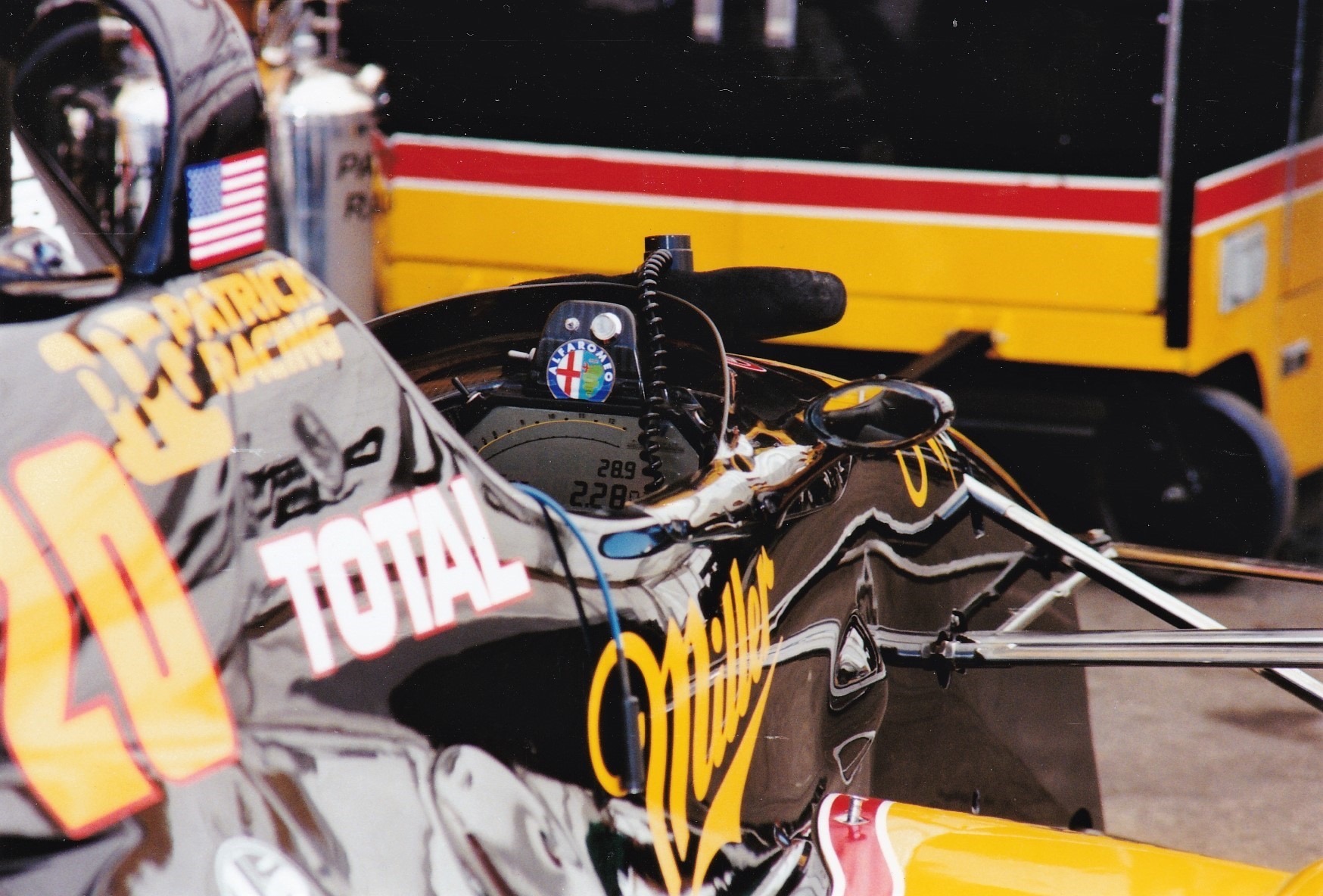
Danny Sullivan’s new office for 1991 (Pic: Mariann Nagy)
Danny Sullivan
“It was the best deal on the table, really. A lot of others had their drivers already locked in, so there were only a few places to go”
Drawing the short straw
The phone line from California is somewhat shaky and unstable at first, when Sullivan and I sit down to discuss this intriguing episode in his storied career. Maybe it is caused by the state's ongoing lockdown related to the coronavirus pandemic, or maybe the phone line is trying to channel the spirit of Alfa Romeo's less-than-perfect IndyCar engine - either way, the crackling line feels oddly appropriate in this context.
While Sullivan was one of the prime factors in Penske's success throughout the 1980s, with an Indy 500 win in 1985, a CART title in 1988 and 12 wins in 110 starts for the team, he knew early on that 1990 would be his last season with Penske. "I had personal connections with the Pennzoil people and I knew already in April that they would leave Penske at the end of that season," he explains. "Now, Emerson was very much tied to Marlboro, so he was there. And Rick Mears wasn't going anywhere, so I knew I was going to draw the short straw. Roger Penske had to lift an option to extend my contract by the summer, and he didn't."
Now a free agent, Sullivan was free to look for greener pastures elsewhere in the paddock, comfortable in the knowledge that he was still highly marketable. After all, he had finished the 1990 season on a high with a win at the season finale at Laguna Seca. At that point, Sullivan and Alfa Romeo were already in advanced talks, but the race win provided a welcome bonus chip in the negotiation game. Or, as he told the Los Angeles Times after the Laguna race: "After today's race I can ask for more money. I was asking for a lot before, but now I can ask for more."
But Patrick Racing and Alfa Romeo were not the only option on the table for 1991, Sullivan recalls. One alternative was the newly started Hall/VDS operation, which had snapped up Pennzoil as a title sponsor and was about to enter IndyCar in 1991 with a Chevrolet-powered Lola. "The Jim Hall thing was early on," says Sullivan. "I don't remember exactly when we had conversations, but it was early on and they had gone away. And then John Andretti signed with them." Andretti, of course, would go on and win the first race of the 1991 season at Surfers Paradise.
Then there was the option of signing with Derrick Walker, who had snapped up most of the assets of the Porsche team after the German squad pulled the plug on its IndyCar operation following the 1990 season. Given the tight bond between Sullivan and Walker from their shared Penske days, a partnership would have made sense. "I had a great relationship with Derrick, but a lot of it has to do with sponsorship and money, and what is available." Funding was indeed an issue for Walker Racing in 1991, and the talks between Sullivan and Walker ended without a deal.
And so he ended up at Patrick Racing. "It was the best deal on the table, really. A lot of others had their drivers already locked in, so there were only a few places to go," says Sullivan. That was not to say that this was a matter of picking the least bad option. For example, there was the financial side of things, as referenced in the LA Times article. It was generally believed that Sullivan had now become one of the, if not the best paid driver in the paddock. Depending on whose numbers you believe (there are several, conflicting press reports from those days), he fetched a fee of between USD 1.5 million and 1.8 million for his services.
As for Patrick Racing itself, ABC's Bobby Unser revealed during an early 1991 broadcast that the team budget was said to be around USD 13 million. Even in 2020 dollars, that would be a massive budget for one season of IndyCar Racing, let alone in 1991. Part of those millions came from the Miller Brewing Company, the Milwaukee-based beer giant that no doubt had fond memories of 1988, when Sullivan won the CART title in a Miller-draped Penske. Obviously Alfa chipped in with quite a few dollars, while former oil man Pat Patrick also displayed a political streak by striking up a commercial deal with the Kuwaiti government amidst the ongoing Gulf War. As a result, the logo of the state-owned Q8 oil conglomerate ended up on the Lola-Alfa.

Early on in 1991, there was a lot of optimism about what the Lola/Alfa/Sullivan combination could achieve (Pic: Mariann Nagy)
And then there was the team set-up. As said, Patrick Racing had already proven its race- and title-winning ways with Emerson Fittipaldi in 1989. That quality had not disappeared overnight, so the crew was one of the best in the business. While the team had lost chief engineer Mo Nunn to the Granatelli/Luyendyk effort for 1991, it had a talented chief mechanic in the form of a young Mike Hull. Whipping the team as a whole into shape was team manager and former Penske veteran Jim McGee.
"I knew Jim well, I knew Pat Patrick well," says Sullivan. "It was a great crew, we had a great chassis and great staff. So it came down to the engine." A visit to Alfa Romeo's facilities in Milan during the off season instilled more optimism in Sullivan: "Alfa was spending really good money, they weren't going cheap at it. The facilities looked great and they had a lot of good people. Giorgio Pianta (the head of Alfa Corse) was a really smart guy."
Plus, rather like the student who tries to cut some corners by copying someone else's homework, Alfa Romeo engineers had a good example to work from. Shortly after Patrick Racing and Alfa Romeo signed their deal for 1990, and shortly before he had to return the Chevy-badged, Ilmor-built engines he used in 1989, Pat Patrick had sent one of the engines to Italy. The idea: take it apart, find out what makes the Chevy tick, and do something similar. It was a decision that would come to haunt Patrick by the end of 1991, but Sullivan was hoping it would pay dividend: "Oh, there was definitely confidence in their engine development, because of the engine they had from Ilmor and the money they were spending."
So at face value, Patrick Racing and Sullivan had fairly realistic expectations ahead of the season. "Realistically, I was hoping that we could be competitive and get a win under our belt if the engine would develop during the season," says Sullivan. "By the end, I wanted us to be competitive with the top teams." Meanwhile, Alfa was convinced that they would find more power after the disappointment of 1990, helped by their ability to strip apart and analyse the Chevy benchmark.
Looking back at that pre-season optimism with what he knows now, Sullivan is philosophical: "You know, every engine manufacturer is going to say how good they are going to be. Every manufacturer will go out and say they will challenge for wins. They have to. And we're all racers and ultimately optimistic, thinking: hopefully the engine guys will make a big push. And Alfa certainly had the manpower, facilities and budget to do it correctly."
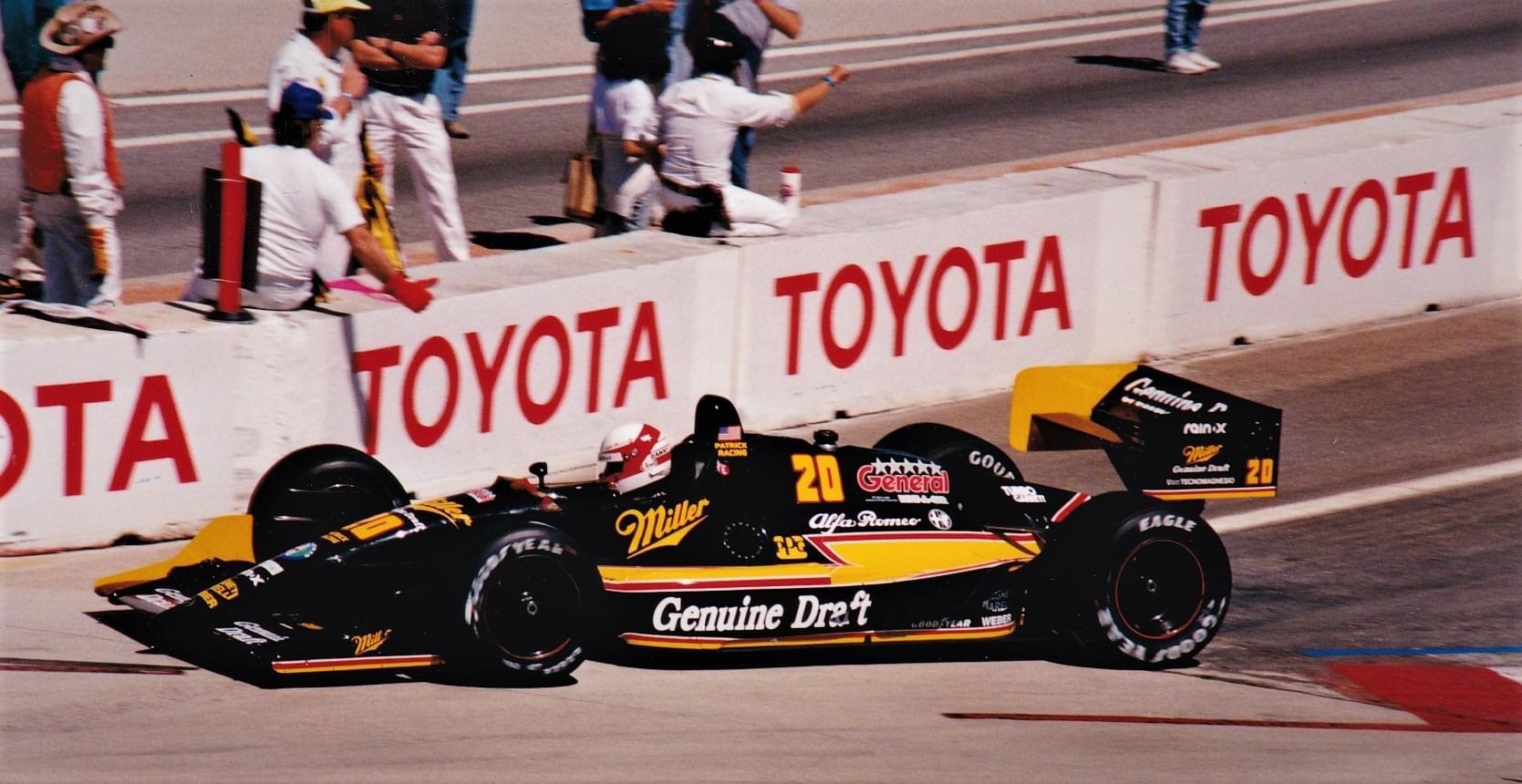
Sullivan was hoping for a win with the Alfa at some point during 1991 (Pic: Mariann Nagy)
Early promise
Initially, the optimism seemed warranted as the 1991 season got off to a good start for Sullivan, Patrick Racing and Alfa Romeo. The season opener on the streets of Surfers Paradise provided confirmation of what the team already knew: there was still plenty of work to be done, but the package also demonstrated potential. Sullivan qualified in tenth and even though he was almost 2.4 seconds off the pole time set by Michael Andretti, he was the fastest non-Chevy driver in the field. Compared to the Chevy, the Alfa engine lacked torque coming off the corners. As a result, Sullivan needed several additional gear shifts each lap to optimize his car's performance, costing him valuable time on top of the speed deficit.
But on Sunday, as the race went green, Sullivan had a good start, passing both Arie Luyendyk and John Andretti in their Chevy-powered Lolas and settling in eighth. In terms of pace the Alfa Romeo was still second best by some distance, but ironically, in a race marked by severe attrition, the engine stayed in one piece - something it certainly would not do later in the season. Sullivan, in turn, managed to avoid the carnage that characterized the race and took the flag in fourth place, behind eventual winner John Andretti, Bobby Rahal and Rick Mears. Andretti had managed to jump him thanks to a lucky caution coinciding with a planned pitstop, but otherwise Sullivan drove a strong race and was not passed by anyone.
The first twelve championship points in the bag, the team headed off to Long Beach for the second race of the season. But at the Californian Pacific coast, the Lola-Alfa simply refused to show anything resembling speed. Sullivan qualified in a weak 16th and ended the race in 11th primarily due to attrition. A glass-half-full guy would say that the car once again finished a race and that Sullivan added two points to his tally, but finishing three laps behind race winner Al Unser Jr was a bitter blow to the team's early optimism.
Yet following the race, the engineers found that the poor performance at Long Beach was largely caused by some faulty wiring, which instructed the engine's fuel injection to go to a lean setting and reduce the potency of the fuel mixture. The result was an estimated loss of 30–40 horsepower. With that problem solved, the team suddenly found itself back towards the front of the grid when the IndyCar circus arrived at the short oval in Phoenix.
Having qualified sixth, the best ever performance for an Alfa-powered car, Sullivan ran with the front runners all race, spectacularly slicing and dicing with the Chevy-powered cars and making life difficult for his former Penske colleagues and the Andretti's. He even led the race for a number of laps, before the engine blew up while he was in fourth behind eventual winner Luyendyk.
"Yeah, after that race in Phoenix I was very encouraged," recalls Sullivan. "We were running in fourth, ran the fastest lap in the race and I remember thinking: this is good, because with a little bit of luck we could have won the race. Just ask Arie! And at Phoenix, the handling is almost more important than power. If the car is handling really well there, you're feeling great. But when you get to Indy, it is all power. And Indy really put us in reverse."
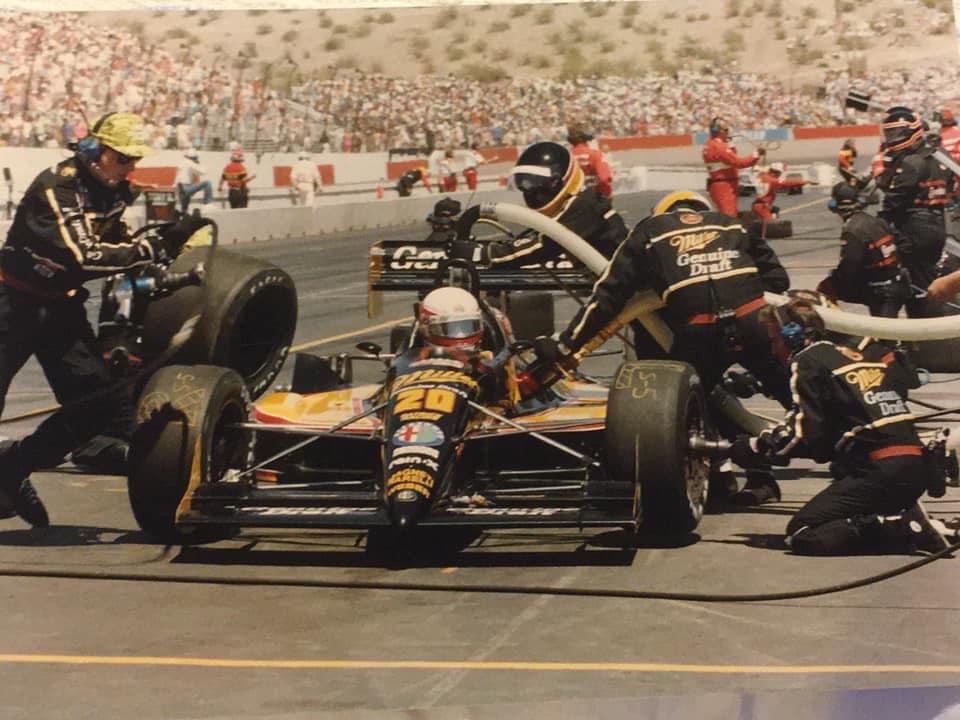
The Phoenix race seemed to confirm the potential in the Lola-Alfa. (Pic: Bruce Hand)
Fourteen days, thirteen engines
Ah yes, Indianapolis. It is undeniably the most important race on the IndyCar calendar, for teams, drivers, sponsors and manufacturers, and there was arguably no other track on the 1991 schedule to which the Alfa Romeo engine was so unsuitable. It turned out the engine blowout at Phoenix would be a sign of things to come during the month of May. Not only did the Alfa miss pure speed and performance, it also responded very poorly to being pushed to the maximum.
"It was crazy," says Sullivan, referring to the first two weeks of practice and qualifying. "I think I blew up thirteen engines in fourteen days!" Worse, his times were nowhere near those set by the Chevy drivers. While the fastest drivers were practicing in the 226 mph bracket and qualified with average speeds above 224 mph, Sullivan struggled to get above 220 miles per hour on average. Meanwhile, Alfa engineers were adamant that their engine was on par with the Chevy, a claim that Sullivan was sceptical about.
"Well, you know how it is. Racers are always a bit more blunt on some stuff," he chuckles. "Alfa kept saying they were making the same horsepower as Chevy, but I wasn't buying it. They were always telling us the engine did well on the dyno back in Italy, but racing is very simple: it is proven on the racetrack, right there. At Indy, the top end is important, and you go through the corners almost flat out. But I was running around flat the whole way around. Don't get me wrong, the people were fantastic. I liked all of them. Except there was this one guy in charge of engine development… it had nothing to do with his personality. But the engine wasn't good, and he thought it was good."
His frustration increasing, Sullivan tried an educational approach. "I just wanted to show him how good our competitors were," he explains. "So this guy, I took him down the pit lane and asked the other teams: do you mind if I show him the rear wing angle on your car? None of the other teams saw us as a threat, so they were like: yeah sure, go ahead Danny. And I showed him: we are running zero rear wing, they are running a lot more rear wing and still they are miles an hour faster than us!"
But the Alfa engineer remained unmoved. "He just kept making excuses," says Sullivan. "At that point, it becomes very frustrating for a racing driver. You would have some enthusiasm if they would say after that: my gosh, you're right, we need to work on this. But this guy, he just didn't want to get it."
Of course, on a dyno the engineers might eventually reach the maximum power output inside an engine. But unlike a dyno run, the straights at Indianapolis are finite. So while in theory the Alfa might have been just as powerful as the Chevy, it took a lot longer to get there. Too long, says Sullivan. "The problem was mostly torque, like: how much is it going to pull coming off the corner? Because when you're coming off Turn 2, or coming off Turn 4, the torque has to be there as well."
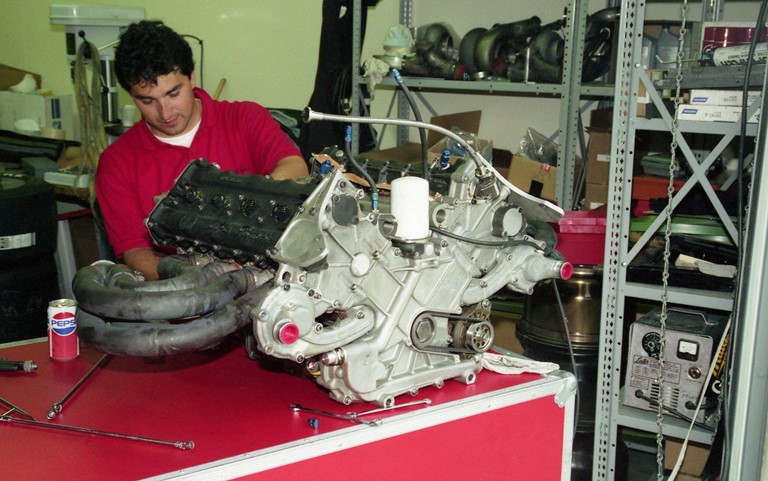
Alfa engineers were putting together a lot of engines during the Month of May… (Pic: March Archives)
Which it wasn't, he adds. "I don't remember the RPM values exactly, but if you come off the corner at 10,000 RPM out of Turn 2, the question is: how quick is it going to pull up to 11,000. Do you get there just before you're turning into Three, or already when you're only halfway on the back stretch? That is what guys are talking about when they talk about cars being 'free' at Indy: that there is seemingly no limit in the car."
Beginning of the end
Despite all the reliability and speed problems, Sullivan qualified the car at a reasonable ninth starting position, on the outside of Row Three. But come race day, mechanical gremlins popped up again and Sullivan actually missed the start of the race because of a broken fuel pump cable. He joined the race a lap down, but managed to work his way back into the top ten despite an additional electrical problem.
Nevertheless, Sullivan struggled to pass people on track because the straight-line speed simply wasn't there. A blown turbo on lap 173, draping the front stretch of the Speedway in an enormous cloud of smoke, was a fitting end to a bitterly disappointing month of May for Sullivan, Patrick Racing and Alfa Romeo. That Sullivan was classified in tenth and picked up three championship points was little consolation.
Yet a week later, at the Milwaukee Mile in Wisconsin, the team was suddenly back on Phoenix form. Sullivan posted a fourth fastest time in qualifying, sharpening Alfa's best qualifying record and no doubt pleasing the numerous guests that had showed up for title sponsor Miller's home race. In the race he finished fifth, albeit three laps down from winner Michael Andretti.

After the disappointment of Indy, Sullivan got a welcome reprieve at Milwaukee as he finished fifth. (Pic: Ronald Spannraft)
Spirits briefly lifted, at the next race in Detroit it was back to disaster mode again. In qualifying Sullivan could do no better than thirteenth, and in the race he finished a distant tenth. Sure, so far he had six points finishes in six races, but the novelty of being part of a development effort started to wear off. Instead, the feeling started sinking in that the team would be also-rans for the remainder of the season.
The racing press started to notice as well. "At Least Sullivan Isn't Driving A Yellow Cab" was the harsh conclusion of a June 1991 article in Allentown, PA newspaper The Morning Call, referring back to Sullivan's one-time job as a cab driver in New York City. The article presented its readers with a frustrated Sullivan, who was clearly fed up with having to make do with an experimental engine programme. He knew it was going to be a challenge, Sullivan told the paper: "But never anything like this."
It wasn't always easy to keep up the spirits, Sullivan admits thirty years later. "You have to be part of the team and show up every day with a positive attitude. But it wasn't always great on race day, because I knew: boy, we're gonna need some luck here and some failures if we're going to make something happen," he reflects. "Everybody wants to win and do well, so at certain stages it was difficult and you were like: not another engine blow up, not another day of no power. That's not fun for anybody. But you're paid to do a job, so you turn up."
What helped soften the blow was the presence of McGee and Hull, Sullivan says. "Jim McGee always had a positive attitude. That doesn't mean he was not pissed off or critical when something went wrong. But he came in every day with a positive outlook on what we were gonna do. Mike Hull was the same, and that attitude filters down to the team. So I always looked forward to coming in and working with those guys. That kind of keeps your spirits up."
Nevertheless, as the mid-way point of the season arrived, Sullivan started thinking beyond 1991. He scored a few more points finishes in Cleveland and at the Meadowlands, but followed that with three straight mechanical retirements at Toronto, Michigan and Denver. A ninth place finish in Vancouver represented a slight improvement, but the Lola-Alfa failed prematurely again during the following races at Mid-Ohio and Road America.
Meanwhile, Alfa Romeo and Patrick Racing had also started drawing their conclusions about the future of the partnership. No matter what the engineers in Italy did, the package would not improve, be it in terms of performance or in terms of reliability. Or as Alfa's engine honcho Giorgio Pianta told Sullivan's hometown paper The Louisville Courier-Journal in August 1991: "I had thought by this time of year we would have been able to solve the problem."

A points finish at the Meadowlands was one of the sparse highlights in the second half of the 1991 season for Sullivan (Pic: Richard Martin)
That statement was revealing. Soon after, Sullivan learnt that Alfa Romeo would pull its factory support for the IndyCar engine programme. "Every manufacturer needs results to go forward, but regardless, I don't think they ever penciled in a five- or ten-year programme," he says. "It was always going to be driven by their sales here in the US. But, you know, everybody wants results." There was never a formal announcement, he adds: "Alfa only had a one-year deal with Patrick. There was an option in the contract to continue, but they didn't pick it up."
Ups and downs
While Sullivan had a good relationship with Pat Patrick, any chance of him staying with the team was subject to Patrick securing a Chevy engine for 1992. And this is where Patrick's earlier trick came back to bite him. Following his little stunt of sending an Ilmor-engineered engine to Italy for Alfa technicians to pick apart, Ilmor was incensed with Patrick. As a direct result, it decided from then on to lease engines only, rather than selling them outright to teams, while all engines were equipped with a not-to-be-broken seal. Oh, and Pat Patrick became persona non grata at Ilmor - the company made it clear he would not get an Ilmor-built Chevy engine even if hell froze over.
That placed Patrick in a difficult situation, leaving him no other choice than to sell the team. He made a deal with willing buyers Bobby Rahal and Carl Hogan, who took over the operation for 1992 and had no issues securing said Chevrolet power plants from Ilmor. The deal also meant the end of Sullivan's time with the team: "I remember, Ilmor was very upset. And when the entity got sold to Rahal and his group, I had to look elsewhere. But it also proved how good the team was. Because Rahal came in with his partners in 1992, the only change he made was to bring in his own engineer, and then they won the championship."
Sullivan instead started talking to Rick Galles and Chip Ganassi about a ride for 1992. "Yeah, there were some discussions with Chip Ganassi, but we couldn't put it together. And then Molson was in play, they wanted a big push in IndyCar and I did a test with Galles which went well." The period with Galles, in the blue-and-white car draped in Molson beer colours, was considerably more successful for Sullivan: especially in 1992 he was reasonably competitive and over two seasons he won two races with the team.
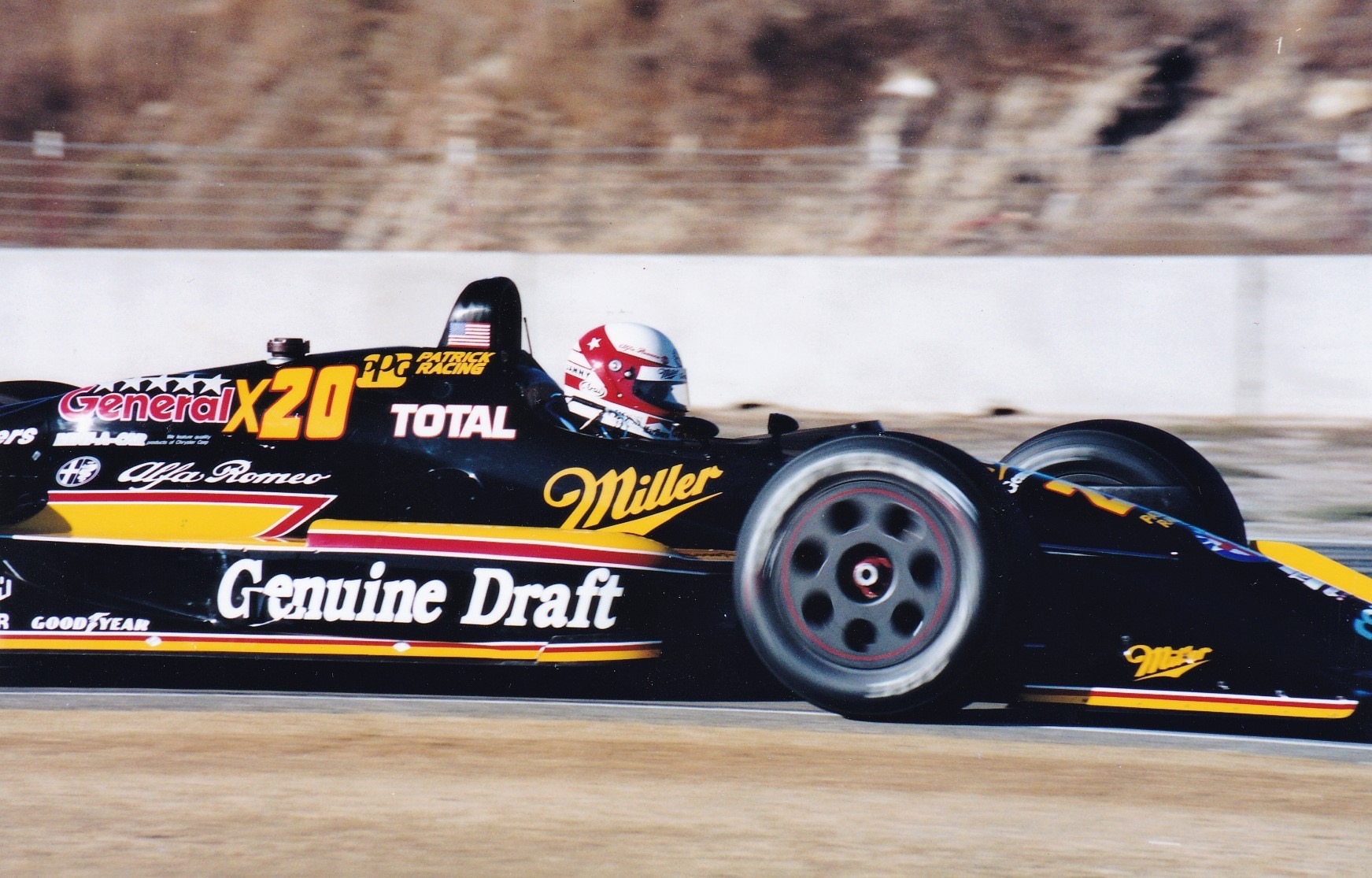
Danny Sullivan, Patrick Racing and Alfa Romeo: what could have been (Pic: Mariann Nagy)
Asked if he has any regrets about his Alfa Romeo adventure, he is philosophical again. "I guess this just comes down to the ups and downs of your career," he reflects. "I wish it would have turned out better obviously, and I also think it would have been good for the series to have another strong engine manufacturer. That would have been a good opportunity for those people that could not get the Chevy."
And he loved being part of the team, he adds. "It was a great group. Unlike in what we have seen recently in other cases, there was never any mudslinging. The Alfa folks were positive and trying to do their best. And I am sure that if Alfa would have stayed, Pat would have continued as well. So from that perspective, it is a bit sad that it didn't work out. You always want to be part of something successful, and being able to lead the charge with something that someone else doesn't have."
In the end, Sullivan says, he is happy with his career. “It would have been nice to have a slightly more steady end, but I had a great career,” he says, as our conversation starts to wind down. “There are only a few drivers who have a consistently great career, and in the end it worked out okay. I’m still here — I got a few bangs along the way, but I’m all good!”
-JD
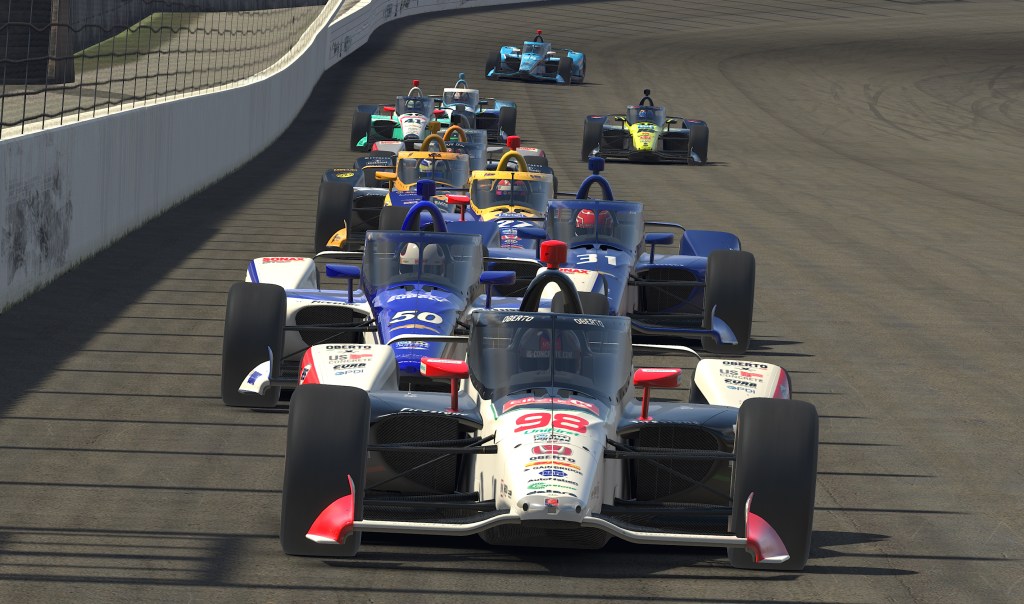
Without real racing, iRacing has proven to be nearly a sigh of relief by giving sponsors much needed exposure on NBC
Like this type of content? Want more?
Submit your email address below so we can email it to you.